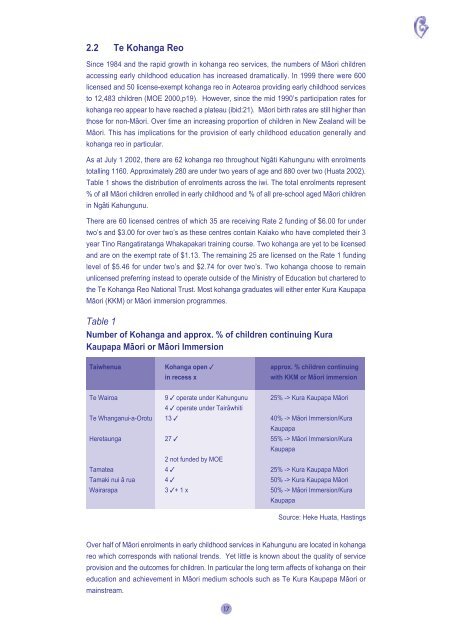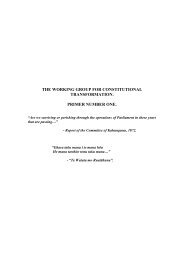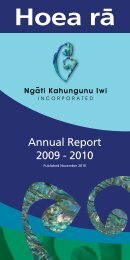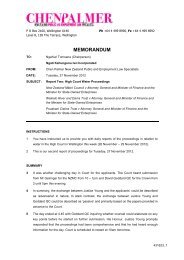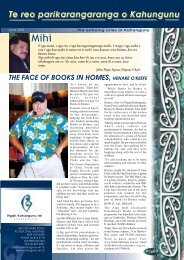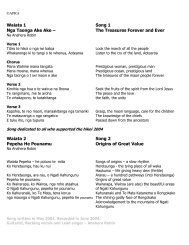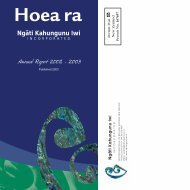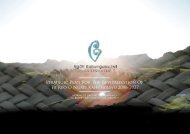Matauranga Strategy - NgÄti Kahungunu Iwi Incorporated
Matauranga Strategy - NgÄti Kahungunu Iwi Incorporated
Matauranga Strategy - NgÄti Kahungunu Iwi Incorporated
Create successful ePaper yourself
Turn your PDF publications into a flip-book with our unique Google optimized e-Paper software.
2.2 Te Kohanga Reo<br />
Since 1984 and the rapid growth in kohanga reo services, the numbers of Mäori children<br />
accessing early childhood education has increased dramatically. In 1999 there were 600<br />
licensed and 50 license-exempt kohanga reo in Aotearoa providing early childhood services<br />
to 12,483 children (MOE 2000,p19). However, since the mid 1990’s participation rates for<br />
kohanga reo appear to have reached a plateau (ibid:21). Mäori birth rates are still higher than<br />
those for non-Mäori. Over time an increasing proportion of children in New Zealand will be<br />
Mäori. This has implications for the provision of early childhood education generally and<br />
kohanga reo in particular.<br />
As at July 1 2002, there are 62 kohanga reo throughout Ngäti <strong>Kahungunu</strong> with enrolments<br />
totalling 1160. Approximately 280 are under two years of age and 880 over two (Huata 2002).<br />
Table 1 shows the distribution of enrolments across the iwi. The total enrolments represent<br />
% of all Mäori children enrolled in early childhood and % of all pre-school aged Mäori children<br />
in Ngäti <strong>Kahungunu</strong>.<br />
There are 60 licensed centres of which 35 are receiving Rate 2 funding of $6.00 for under<br />
two’s and $3.00 for over two’s as these centres contain Kaiako who have completed their 3<br />
year Tino Rangatiratanga Whakapakari training course. Two kohanga are yet to be licensed<br />
and are on the exempt rate of $1.13. The remaining 25 are licensed on the Rate 1 funding<br />
level of $5.46 for under two’s and $2.74 for over two’s. Two kohanga choose to remain<br />
unlicensed preferring instead to operate outside of the Ministry of Education but chartered to<br />
the Te Kohanga Reo National Trust. Most kohanga graduates will either enter Kura Kaupapa<br />
Mäori (KKM) or Mäori immersion programmes.<br />
Table 1<br />
Number of Kohanga and approx. % of children continuing Kura<br />
Kaupapa Mäori or Mäori Immersion<br />
Taiwhenua Kohanga open ✓ approx. % children continuing<br />
in recess x<br />
with KKM or Mäori immersion<br />
Te Wairoa 9 ✓ operate under <strong>Kahungunu</strong> 25% -> Kura Kaupapa Mäori<br />
4 ✓ operate under Tairäwhiti<br />
Te Whanganui-a-Orotu 13 ✓ 40% -> Mäori Immersion/Kura<br />
Kaupapa<br />
Heretaunga 27 ✓ 55% -> Mäori Immersion/Kura<br />
Kaupapa<br />
2 not funded by MOE<br />
Tamatea 4 ✓ 25% -> Kura Kaupapa Mäori<br />
Tamaki nui ä rua 4 ✓ 50% -> Kura Kaupapa Mäori<br />
Wairarapa 3 ✓+ 1 x 50% -> Mäori Immersion/Kura<br />
Kaupapa<br />
Source: Heke Huata, Hastings<br />
Over half of Mäori enrolments in early childhood services in <strong>Kahungunu</strong> are located in kohanga<br />
reo which corresponds with national trends. Yet little is known about the quality of service<br />
provision and the outcomes for children. In particular the long term affects of kohanga on their<br />
education and achievement in Mäori medium schools such as Te Kura Kaupapa Mäori or<br />
mainstream.<br />
17


